Dahlias have become quite the favorite flower. Dare I say they’ve even become a bit trendy? I hate the idea of a flower being a fad. I prefer to chalk up the interest in dahlias to a combination of access to lovely new varieties, more information available on how to grow them and social media nudge from floral designers and growers (such as Erin at Floret Flowers) who show them at their most beautiful.
If you grow dahlias as annuals from tubers the cost of them can add up. But if you put in a little extra work and store them over winter (in areas where it is too cold to overwinter them in the ground, which is anything colder than zone 8, although you can sometimes sneak by in zone 7 with a thick layer of mulch), the cost becomes much more realistic. But I like to save dahlias because some varieties can be difficult to find, so once you have a good one it’s best to save it yourself.
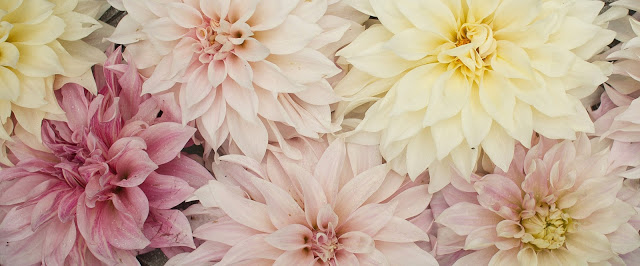
I’ve tried a variety of methods for dahlia storage, some more successful than others. It’s one of those things that I think I may be overthinking to be honest. Some directions for storing dahlias are no more complicated than sticking them in a unclosed plastic bag and I’ve heard from lots of people who throw them in a plastic crate and walk away.
Regardless of what method you use for storing dahlias, and I’ll get to more on that, when you store them is important. You want to wait until there is a killing frost before you do anything. You’ll know it when you see it: One morning you will wake up and your previously beautiful dahlias will have turned nearly black and flopped over. Most tutorials will tell you to cut the stems back to about 4 inches at this point, but I will admit that this year I skipped that step. Part of the issue with that is that dahlia stems are hollow and if you leave that hollow stem open, water will get in and rot the tuber, and that is exactly what we’re trying to avoid. It’s recommended that you cover them. In the past I’ve covered the stem holes with aluminum foil.
The point of this exercise is to first “tell” the tuber that it’s time to go dormant by waiting for the killing frost and then to have the tuber focus on storing all nutrients, rather than having them to to the stems and leaves, before you dig. That’s a whole bunch of anthropomorphism there, and obviously I don’t believe that my dahlias, no matter how fabulous they are, have the ability think, but you get the idea.
After you’ve done all this, you want to wait a bit, maybe two weeks, before you dig them up, although no matter what you must do this before it gets too cold, so it’s better to do this sooner rather than later.
Here’s where I insert a lesson I’ve learned time and time again: Mark your dahlias before you dig them! I know you think that somehow you have a superhuman ability to remember which tubers are which even though they all look like a bunch of deformed potatoes, but you don’t. I speak from experience here.
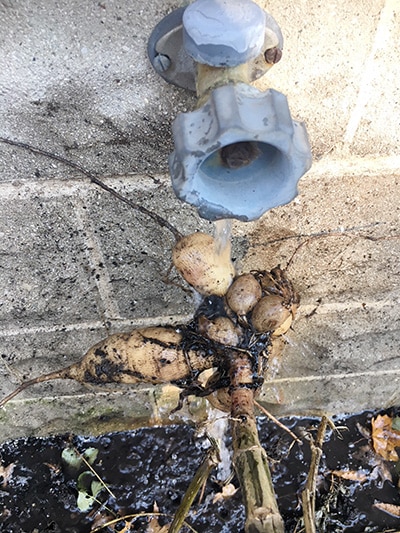
Labeling accomplished, dig them carefully. I use a gardening fork (the kind on a long handle) and carefully work my way around the base of the plant, giving it plenty of room. Any tubers that are damaged in any way must be tossed, so do your best not to spear any. Then I wash them off with the hose (or straight out of the spigot). Judging by the number of people who say you don’t have to do this step, I think you could skip it, but I prefer a cleaner tuber so it is easier to inspect for damage and for more labeling later on.
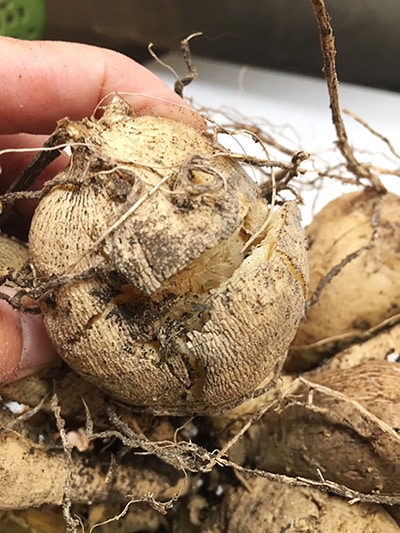
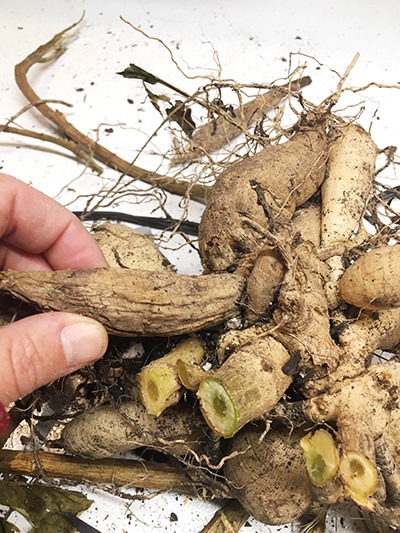
Rinsed tuber clusters (and you will be amazing how much the single tuber you planted in spring has multiplied) then go to a cool basement to dry for a couple days. Remove any tubers that are not firm or are damaged in any way. You can cut the little root off them if you want to clean them up further but it is not necessary.
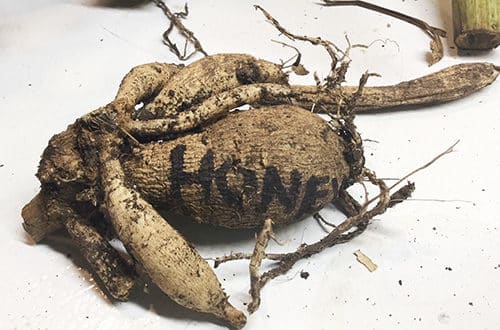
And this is where you decide how to store them. Three years ago I packed them in peat in a big plastic bin and stored them in my parents’ slightly heated garage. When I opened them up in spring, almost all of them had turned to dust. They simply dried up. I think I used very old peat moss and it sucked all the moisture out of them.
Last year I followed this method of wrapping them in plastic wrap. I know that sounds crazy right? It’s highly labor intensive and requires dipping them in a weak bleach solution and dividing them into individual tubers before storage. I stored my plastic packages in the coldest corner of our basement and had a great success rate using this method. The problem with it though is that I don’t really want to start with individual tubers every year. I don’t need dozens of dahlias; I need a few large dahlias.
So this year I’m back to storing the full clusters of tubers that I dug up. Prior to storing them I used a Sharpie to write the name on the tuber clusters in several places in hopes that I won’t lose track of what’s what come spring. I again packed them in a large plastic tub, but this time I used animal bedding wood shavings that I picked up at the feed store. Not only is it more eco-friendly than peat, I also believe it will be less likely to draw moisture out of the tubers. Each cluster was packed with lots of shavings around it so it wasn’t touching any others. I sprinkled just a little water on top of the top layer of wood shavings just to keep some (but not too much) humidity in the bin and I’ll check it again in mid winter.
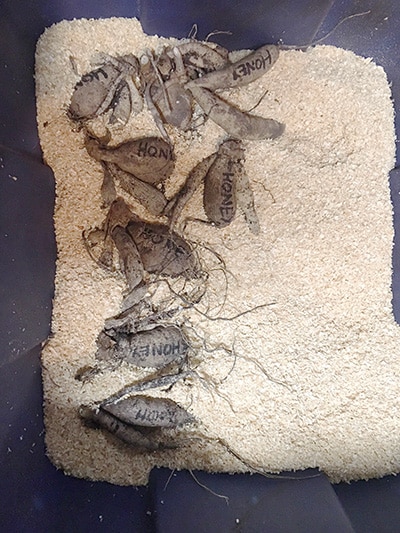
Like I said, I’m probably making this into a bigger deal than it needs to be. But I love my dahlias and I want them to enjoy their winter break so they can show me their appreciation next summer. What’s that I was saying about anthropomorphizing?

23 Responses
I’ve been struggling with this for the past few weeks. I’ve grown dahlias for the first time this year and really want to preserve the tubers, but I also really, really don’t want to use plastic wrap. It’s just so bad for the environment that I never use it for anything and I certainly can’t use it for the garden. I’m going back and forth between wood chips and vermiculite, but need to decide ASAP.
I have used peat moss In cardboard boxes stored in my crawl space for the past few years but if it has too much moisture they rot and last year many of them dried up as I believe the peat was too dry (saved from last year) and sucked out the moisture from the tubers. This year I am using plastic bins with holes drilled in them and wood chips. I sure hope this works as I am doing the lot of them ( a few hundred). I shall keep my fingers crossed.
Thanks for sharing this idea! How is this method working out for you?
Thank you so much for this sound advice on storing dahlias. I usually just buy new ones (Zone 6) in the spring at the Philadelphia Flower Show, but this year we had so many fine ones that I don’t want to even try to replace. Marking them with a sharpie is brilliant. So is the bleach solution dunk. Again, thank you!
I just finished wrapping my dahlia tubers. But I didn’t wrap each one individually. Took the whole connected bunch and wrapped em up after bleach water dip and a thorough dry out. Brooklyn apt here so I’m turning off radiator in one room, keeping window ajar, closing doors and storing in there. Hopefully they’ll be ok. Spare bedroom as dahlia storage. Shows you where priorities lie.
Do you put the cover on the plastic bin you are storing the dahlia tubers in?
Great info…what do I do with them in the spring?
After many,many years I’m trying 1 called Juanita ,a type developed in 1949, because I live w my sister Juanita and her teen son. The tuber will arrive spring, 2020. Thanks for all the your advice and experiences w winter storage. Will keep them in mind a year from now. Mike in Zone 5,Iowa
So, it’s now spring 2019! How did your tuber storage work back in winter 2017?
I have been growing dahlias for five years. We insulted the garage two years ago so the tubers would be nice and warm throughout the winter. They did great last year, but several of them are rotting this year. So sad! My soil is always wet when I dig, but I make sure they are dry before storing. I also wash them off because they are so packed with soil, wet soil. The temperature always stays between 40-50. Any thoughts as to why they are rotting? When I checked them in December, they were fine. In January, I started to find soft tubers. I checked them two weeks later, more soft tubers. Sometimes I think I do too much to them to them. They are my babies!!!!
Thanks so much Erin, excellent advice.
Serge, Ottawa, Canada
Always a hit or miss for me. I do much as you suggest but simply wrap them in newspaper, place them in a paper shopping bag, and store them in a cool, dark room on the concrete floor in the basement. Very little climate or environment change. (Go to sleep you tubers)
This year I did try placing a few in plastic bags that I perforated and then in paper shopping bags. We’ll see what we get.
In the end, I’ve been planting/growing Dinner Plate Dahlias forever because they are an excellent cutting flower and peak when everything else is basically “done” for the season. I don’t really care if I have to buy new tubers because the pleasure and number of flowers I end up getting far out weigh the cost. Yah.
You gotta love those dinner plate dahlias! No other flower can make an impact like that.
Too much work for this gardener. I don’t have a good place to sore them if I did all this. Best of luck to you. I will be curious if your wood chips work.
Well that’s the good thing about them, right? They aren’t so expensive that you can’t just start fresh every year if you want to.
I totally forgot about my one Dahlia in the garden and I assume it is dead as we’ve had so many freezing days and nights. You will have to report on this method in the spring so we know if it works. I would probably consider buying and overwintering a few of these flowers if I knew of an easy and surefire way to save them. Seems like you many have found it. The first photo is good enough to eat. Such a yummy looking flower!
I’ll report back in spring!
I’ve always wanted to learn how to store dahlia tubers over the winter. Thanks for sharing this! Ann
You’re welcome! Thanks for stopping by!
When your clusters become too large, do you quarter them? Thank you.